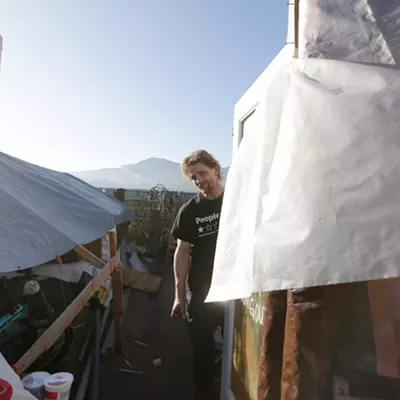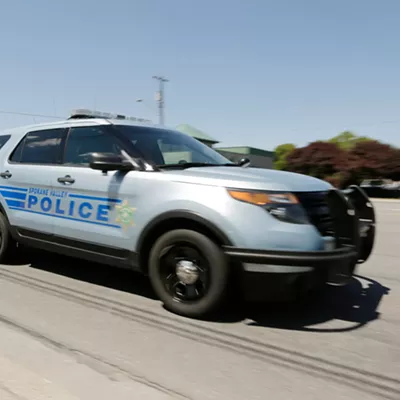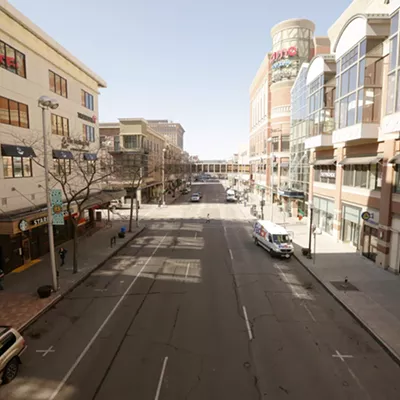
Rural America covers nearly three-quarters of the country. More than 96% of the land in Washington is rural, and it's home to about 16% of the state's population, according to the 2020 census.
"Urban communities are dependent on rural communities," says Amy Hause, deputy director of Rural Development Initiatives, a regional nonprofit. "Everyone's dependent on rural communities — for food, for natural resources, for caring for the resource of the land."
It's critical, she says, for the people living in rural areas to thrive — for economic vitality, environmental health and national security. But all across Eastern Washington, small towns are at risk of disappearing.
"There's somehow this assumption that we invest in urban, but there's not the same assumption that we invest in rural," Hause says. "But there are assets there, and to not invest in them and sustain them and improve them is a waste. It's a throwaway mindset."
A few towns in southeastern Washington, long abandoned by now-defunct 20th century railroads, are finding new ways to give their communities staying power — both for themselves and for tourists who might otherwise pass them by.
The towns of LaCrosse, Colfax and Palouse are investing in new sewer systems, aesthetic apartments and Airbnbs. They're hoping to capitalize on the slow but steady migration from urban to rural areas since the start of the COVID-19 pandemic.
Net migration increased the population of nonmetro areas across the country at a rate of 0.51% from 2022 to 2023, which offset the 0.27% loss from more deaths than births in the same areas.
The communities' early efforts are scrappy, slow, and often paid for by state or nonprofit partners. That means the current limbo of federal grants isn't completely stalling early rural revitalization efforts in Eastern Washington. But as communities get ready to tackle bigger, more permanent projects, the uncertainty of federal funding could quell the momentum.
"It's important to keep [us] on the map," says Sarah Kane, executive director of the nonprofit LaCrosse Community Pride. "We don't want to be forgotten."
'HAYWIRE AND DUCT TAPE'
LaCrosse used to have a housing crisis.
In the early 20th century, trains brought cars full of laborers to help plow acres of new wheat across the basalt-riddled fields of Whitman County. The town took the rocks tossed aside by the farmers and built bunkhouses for those farmhands near the railroad tracks.
But soon, machines started replacing manpower. By the end of the 1960s, the bunkhouses weren't necessary anymore. Then, LaCrosse families started encouraging their kids to leave home.
"You always want your children to do better than yourself," Kane says. "So there was a real push for kids to get off the farm ... which unfortunately has led to a downturn in our population."
LaCrosse's population has hovered around 300 people for at least the last decade. The town, roughly an hour-and-a-half southwest of Spokane, has a lot of senior residents, many of whom moved from the west side for cheaper land and a quieter retirement, Kane says. The town's population is probably made up of about half longtime residents and half more-recent arrivals, she estimates.
Kane and LaCrosse Community Pride are spearheading efforts to revitalize the town so it can be a viable home for young people, too. To get going, she says, it's critical to get residents spending money in their own town.
"Your businesses are the ones that support the other facets in the community," Kane says. "It's our businesses that are supporting the Parks and Rec [department] and buying uniforms. It's our businesses that are supporting the 4-H kids and FFA kids."
To keep LaCrosse dollars in LaCrosse, the nonprofit renovated and owns a 1914 mercantile building that's now a grocery store, library and community center. The grocery store can't provide all the fresh produce that the town needs, and its profits don't cover its rent, but keeping it open is more of a community service, Kane says — it gets people in the habit of thinking locally first.
There is one way, though, that other cities can help LaCrosse become self-sufficient. In 2023, LaCrosse became the state's smallest Washington Main Street community through the Washington Trust for Historic Preservation.
Businesses across the state can donate their business and occupation tax or public utility tax to Main Street communities. The donating businesses can get a federal tax credit for the charitable contribution, and struggling communities get funds to kickstart projects like renovating buildings, installing new infrastructure or even fixing a broken pool motor in the heat of summer.
"Being so small, it's really, really hard to generate that kind of support," Kane says. "Being a Main Street community, that opened the doors."
But there's still plenty of work to do. LaCrosse Community Pride renovated a warehouse five years ago that brought a manufacturing company to town, but that company recently gave up its lease. LaCrosse now has an up-to-date, empty building that could be great for manufacturing or even a small brewery, Kane says, but it's been difficult to attract potential businesses.
There used to be a cafe, too, that displayed art from an Endicott artist and supported a mobile food bank. But the kitchen needs a new hood — a major setback for any restaurant.
"Finding $100,000 is a little bit tough," Kane says.
It's hard to break the downward spiral of fewer people, fewer dollars and fewer opportunities. Kane moved to LaCrosse with her family 10 years ago from Palouse. She hopes a few more families will move to the town, especially now that more people have the opportunity to work remotely after the pandemic. The town has great internet speeds, she says, but so far, that hasn't done enough to draw a younger crowd.
But there might still be a way to reverse the spiral.
The bunkhouses that were formerly used by a thriving population could be a recycled solution. LaCrosse Community Pride renovated two basalt bunkhouses and listed them on Airbnb in early 2023.
"There's WSU parents that come and stay. We have a group of hunters that come and stay because they hunt in the area," Kane says. "I want to show off our community, and it's a unique experience that plays into our history."
By preserving the past, LaCrosse may be paving the way for the future. Get the cafe going and maybe a local brewery, and slowly, LaCrosse could become a road trip must-see instead of a bypassed town.
"I'm a really firm believer that rural people are real innovators, and they can do a lot with a little bit of haywire and duct tape," Kane says.

UPSTAIRS DOWNTOWN
"We just got our first booking!" Whitney Bond says to Allie Cofer in a loft above Colfax's Main Street.
The loft has a tiled kitchen with brand new white stone countertops and gilded accents throughout. Bond and Cofer renovated the upstairs of the century-old building themselves, then listed it on Airbnb a few days ago. Now, it's already booked for the first weekend in May.
"There has been apathy here for decades," Cofer says. "But rural communities are not this podunk little thing."
Bond and Cofer run the Colfax Downtown Association, a nonprofit dedicated to the beautification and revitalization of downtown Colfax, a town of almost 3,000. What started with installing sidewalk flower pots in the summer has blossomed into the early stages of what Bond and Cofer are calling "Upstairs Downtown," a way to turn the upper floors of vintage downtown buildings into apartments that the city needs to attract the population growth it wants.
"I feel like we need to utilize what we already have," Bond says.
New housing needs new infrastructure, which adds even more expense to new development projects, she says. Plus, Colfax is nestled in a valley, so even moderate growth is hemmed in by the hills.
But most of the buildings downtown have empty second and third floors, Bond says. Colfax is also a Main Street community through the state historic trust, and to enliven their main corridor, the association wants to empower business owners to convert their upstairs into short- or long-term rentals.
New apartment dwellers would complement the businesses supported by Colfax's small business incubator, a collaboration between the Colfax Downtown Association and the Washington state Department of Commerce.
The incubator provides rent subsidies, budgeting help and professional development to participating early entrepreneurs. Colfax doesn't lack good business ideas — it lacks healthy opportunities, Bond says.
"I'm a really firm believer that rural people are real innovators."
Through the incubator, Annie Ruth, a candle and skin care company, shares a building with The Cellar, a swanky new wine bar.
Kylie Pietila started Annie Ruth in 2019 under a different business name and moved the business to 201 N. Main St. in 2022. The new location gives her a larger space to host bridal showers, baby showers and birthday parties, sometimes collaborating with the wine bar next door.
"I'm a '90s kid, and I crave that vibe of putting your phone down and doing things," she says.
Revitalizing a small town builds community, encourages people to stay longer in rural areas and inspires people who are sitting on their ideas, Pietila adds.
Trevor Miller had an idea of starting a food truck in Colfax. But thanks to the small business incubator, he was able to start a brick and mortar restaurant in a converted bank building instead. In August 2024, his Wild Ember Kitchen opened to both locals and tourists. Cougar fans have started to notice it on their way to football and basketball games, Miller says.
"There was a longtime fear that [Colfax] would be a drive-through town," Miller says. "I don't think we're out of the woods yet."
But Miller says he thinks the town is in an upswing.
Beautifying Colfax not only instills pride in residents, Bond says, but hopefully will attract the admiration of some of the passers-by in the 10,000 cars that drive through the town on any given day — all by "taking care of the foundation that's already built," she says.
'CRAZY TALK'
Kane, Bond and Cofer all mentioned Palouse as a revitalization inspiration. Not the Palouse region, but the town of Palouse, a 1,000-person community 15 miles north of Pullman.
Palouse received national recognition for cleaning up contaminated land, called a brownfield, and redeveloping it into a thriving veterinary clinic and a brewery.
On its main drag, the town also currently has a local handmade goods store, a popular consignment store and a newspaper museum.
"It's really important to develop relationships with partners who can help you," says Mayor Tim Sievers.
Palouse isn't done. After nurturing great relationships at the state level, it's also building new partnerships with larger funding partners, including the federal government, for even more expensive projects.
Case in point: Palouse needs a new sewer system. Eastern Washington's previous congressional representative, Cathy McMorris Rodgers, secured a federal appropriation for Palouse's new sewer before she retired.
"It's a little more than a million dollars," Sievers says. "It's through the Environmental Protection Agency, and I think that we're going to get that one."
Sievers isn't certain though, because most federal funding is currently in limbo as the new Trump administration aggressively reconsiders all government spending. National uncertainty is affecting Washington state's budget, too.
"[The state budget] hasn't been passed, but there's another million dollars for Palouse in there," Sievers says. "I feel much less confident that it will be there, given the uncertainty."
LaCrosse, too, is feeling the uncertainty. Kane was hoping for a $50,000 grant from the United States Department of Agriculture, which would make up about a quarter of her goal budget. But now she's not expecting it to come through.
It's not clear whether the federal guidance that prompted past projects will be impacted, too, Sievers says.
"This may be just crazy talk, but it's like, will the Environmental Protection Agency even be here in a year?" he says. "Are they going to totally change all the regulations so that the project that we've been working on for 15 years to meet their standards, all of a sudden becomes irrelevant? I have no idea. We're just going to have to roll with the punches as we learn and see how things unfold. We're not in control of any of that. But what we can do is advocate with the people who represent us and who are going to influence some of those decisions." ♦

























